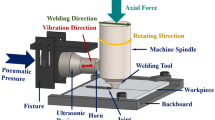Abstract
This paper presents a new mathematical model of wiredrawing with ultrasonic vibration based on the nonlocal friction theorem for overcoming the inadequacy in describing the friction effect by the conventional classical Coulomb friction model. The friction stress distribution, the contact pressure distribution, and the drawing force were obtained by employing Taylor’s series, von Mises yield criterion, the velocity field theorem, power balance analysis, and a numerical solution method developed in MATLAB®. The ultrasonic antifriction effects of three different wires, including a copper wire, a stainless steel wire, and a titanium wire, were evaluated. The results point out that the antifriction effect of ultrasound on the titanium wire is the most obvious and then followed by the stainless steel wire and the copper wire; the ultrasonic amplitude has observable effects on the drawing force reduction, while the drawing speed has no visible effect on the drawing force. The experimental system of wiredrawing with ultrasound was designed. The experimental results verify the validity of the modeling and the theoretical analysis. The present work provides a new methodology to predict the contact mechanics and tribology property of wiredrawing with ultrasound for metals, especially for difficult-to-draw materials.
Similar content being viewed by others
References
Tawakoli T, Azarhoushang B, Rabiey M (2009) Ultrasonic assisted dry grinding of 42CrMo4. Int J Adv Manuf Technol 42:883–891
Singh R, Khamba JS (2009) Mathematical modeling of tool wear rate in ultrasonic machining of titanium. Int J Adv Manuf Technol 43:573–580
Kumar J, Khamba JS (2010) Modeling the material removal rate in ultrasonic machining of titanium using dimensional analysis. Int J Adv Manuf Technol 48:103–119
Qi H, Shan X, Xie T (2009) Design and experiment of the high speed wire drawing with ultrasound. Chinese J Mech Eng (English edition) 22:580–586
Murakawa M, Jin M (2001) The utility of radially and ultrasonically vibrated dies in the wire drawing process. J Mater Process Technol 113:81–86
Siegert K, Möck A (1996) Wire drawing with ultrasonically oscillating dies. J Mater Process Technol 60:657–660
Langenecker B (1966) Effects of ultrasound on deformation characteristics of metals. IEEE Transactions on Sonics and Ultrasonics 13:1–8
Siegert K, Ulmer J (2001) Influencing the friction in metal forming processes by superimposing ultrasonic waves. CIRP Ann Manuf Technol 50:195–200
Hayashi M, Jin M, Thipprakmas S, Murakawa M, Hung JC, Tsai YC, Hung CH (2003) Simulation of ultrasonic-vibration drawing using the finite element method (FEM). J Mater Process Technol 140:30–35
Oden JT, Pires EB (1983) Nonlocal and nonlinear friction laws and variational principles for contact problems in elasticity. J Appl Mechanics 50:67–76
Avitzur B (1968) Metal forming: processes and analysis. McGraw-Hill, New York
Susan M, Bujoreanu LG, Găluşcă DG, Munteanu C, Mantu M (2005) On the drawing in ultrasonic field of metallic wires with high mechanical resistance. J Optoelectronics Adv Mater 7:637–645
Hosseinabadi HG, Serajzadeh S (2011) A coupled stream function-finite element analysis for wire drawing processes. Int J Adv Manuf Technol 57:917–926
Kumar VC, Hutchings IM (2004) Reduction of the sliding friction of metals by the application of longitudinal or transverse ultrasonic vibration. Tribol Int 37:833–840
Susan MM, Dumitras GP, Dragos Cristian AC, Viorel ID, Bogdan Lucian GC (2010) Modification of mechanical characteristics of 10TiNiCr180 stainless steel tubes in the process of drawing under the action of ultrasonic vibrations. Surf Eng Appl Electrochem 46:57–63
Lei X, Rui W, Yong L (2011) The optimization of annealing and cold-drawing in the manufacture of the Ni–Ti shape memory alloy ultra-thin wire. Int J Adv Manuf Technol 55:905–910
Author information
Authors and Affiliations
Corresponding authors
Rights and permissions
About this article
Cite this article
Shan, X., Qi, H., Wang, L. et al. A new model of the antifriction effect on wiredrawing with ultrasound. Int J Adv Manuf Technol 63, 1047–1056 (2012). https://doi.org/10.1007/s00170-012-3976-8
Received:
Accepted:
Published:
Issue Date:
DOI: https://doi.org/10.1007/s00170-012-3976-8



